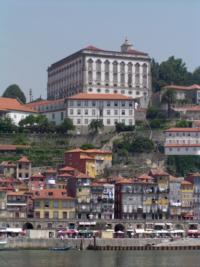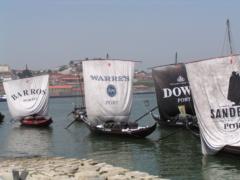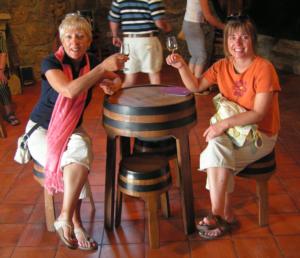A Rally excursion from Povoa de Varzim
The second city of Portugal, Porto is famous throughout the world for the fine wine that bears its name; the city is also an important cultural and historical centre. Settled by the Romans, the twin towns of Portus and Cale, facing each other across the Douro River, have given their names to the whole country, Portucale - Portugal. Referred to as the Capital of the North, it is an excellent place from which to explore the region; the countryside is green and hilly, with rivers running in deep ravines down to the sea. The sparse rocky shores of Galicia have given way to a gentler coastline, but not the plains and sand dunes found further south.
 Historically, the City played an important role in the development of Portugal and in the beginnings of European colonial expansion. Prince Henry the Navigator, was born in Porto, and fitted out ships here for expeditions to North Africa. In the 15th Century, Portugal led Europe in the development of ocean going ships and celestial navigation, sending ships down the African coast and to India, returning via the Atlantic islands. The wealth that flowed back to Portugal from African gold, Indian spices and later Brazilian sugar, allowed rich merchants to build elegant town houses and endow beautiful churches. Rococo and baroque styles predominate the architecture of municipal buildings, merchant’s houses and churches in the old town. Those not afraid of heights can visit the 18th century baroque Clérigos Church and climb the 225 steps to the top of the Torre dos Clérigos, and enjoy a panoramic view of the city. The Torre, one of Europe’s highest bell towers, has also over the centuries provided an invaluable navigation mark to seafarers.
Historically, the City played an important role in the development of Portugal and in the beginnings of European colonial expansion. Prince Henry the Navigator, was born in Porto, and fitted out ships here for expeditions to North Africa. In the 15th Century, Portugal led Europe in the development of ocean going ships and celestial navigation, sending ships down the African coast and to India, returning via the Atlantic islands. The wealth that flowed back to Portugal from African gold, Indian spices and later Brazilian sugar, allowed rich merchants to build elegant town houses and endow beautiful churches. Rococo and baroque styles predominate the architecture of municipal buildings, merchant’s houses and churches in the old town. Those not afraid of heights can visit the 18th century baroque Clérigos Church and climb the 225 steps to the top of the Torre dos Clérigos, and enjoy a panoramic view of the city. The Torre, one of Europe’s highest bell towers, has also over the centuries provided an invaluable navigation mark to seafarers.
 Any visitor to Porto must try its most famous export, the full-bodied fortified wines which grace the worlds’ finest dining tables. The vines are grown inland up the steep valley sides, and the grapes harvested in September and October. Pressed and fermented where they are grown, the new wine is brought down river to Gaia in casks loaded on rabelo boats, traditional square rigged barges. In Gaia the Casa do Douro selects the best wines which will produce the unique Port wine. This wine is “musted” by adding brandy and allowed to mature for several years in the cellars of the Porto Wine Lodges. Vintage port, the unblended wine from a single exceptional harvest will continue maturing after bottling, sometimes for up to fifty years. English merchants played a significant role in expanding the port wine trade. The Methuen Treaty of 1703 gave preferential treatment to this “generous” wine which so pleased English palates. The unfortified wines or Vinho Verde should not be overlooked with names such as Mateus, Vila Real and Pinhão synonymous with fresh tasting white or fruity red wines that can be enjoyed with the local cuisine.
Any visitor to Porto must try its most famous export, the full-bodied fortified wines which grace the worlds’ finest dining tables. The vines are grown inland up the steep valley sides, and the grapes harvested in September and October. Pressed and fermented where they are grown, the new wine is brought down river to Gaia in casks loaded on rabelo boats, traditional square rigged barges. In Gaia the Casa do Douro selects the best wines which will produce the unique Port wine. This wine is “musted” by adding brandy and allowed to mature for several years in the cellars of the Porto Wine Lodges. Vintage port, the unblended wine from a single exceptional harvest will continue maturing after bottling, sometimes for up to fifty years. English merchants played a significant role in expanding the port wine trade. The Methuen Treaty of 1703 gave preferential treatment to this “generous” wine which so pleased English palates. The unfortified wines or Vinho Verde should not be overlooked with names such as Mateus, Vila Real and Pinhão synonymous with fresh tasting white or fruity red wines that can be enjoyed with the local cuisine.
 For 2007, Rally crews will enjoy a tour around the Taylor Fladgate Wine Lodge. Now in its fourth century, Taylor Fladagte is accepted by most wine authorities to be the greatest of all port shippers, famous especially for its sublime and long-lived Vintage ports, which consistently fetch the highest prices at auction, and for old, distinguished Tawny ports. But Taylor's is also an innovative house, pioneering the successful Late Bottled Vintage style, which has been copied by almost every other shipper. During the tour participants are given the opportunity to learn about the fascinating history of Port wine, as well as that of the House of Taylor Fladgate. Upon completing the tour they will be invited to taste two Port wines in the elegant Library Room.
For 2007, Rally crews will enjoy a tour around the Taylor Fladgate Wine Lodge. Now in its fourth century, Taylor Fladagte is accepted by most wine authorities to be the greatest of all port shippers, famous especially for its sublime and long-lived Vintage ports, which consistently fetch the highest prices at auction, and for old, distinguished Tawny ports. But Taylor's is also an innovative house, pioneering the successful Late Bottled Vintage style, which has been copied by almost every other shipper. During the tour participants are given the opportunity to learn about the fascinating history of Port wine, as well as that of the House of Taylor Fladgate. Upon completing the tour they will be invited to taste two Port wines in the elegant Library Room.
Following the morning tour, Rally crews will have the afternoon free to explore the City of Porto.
http://www.fladgatepartnership.com/